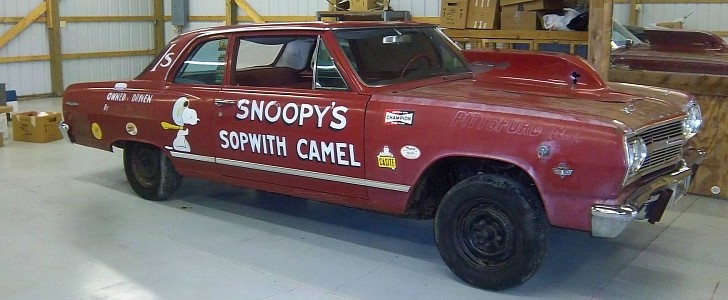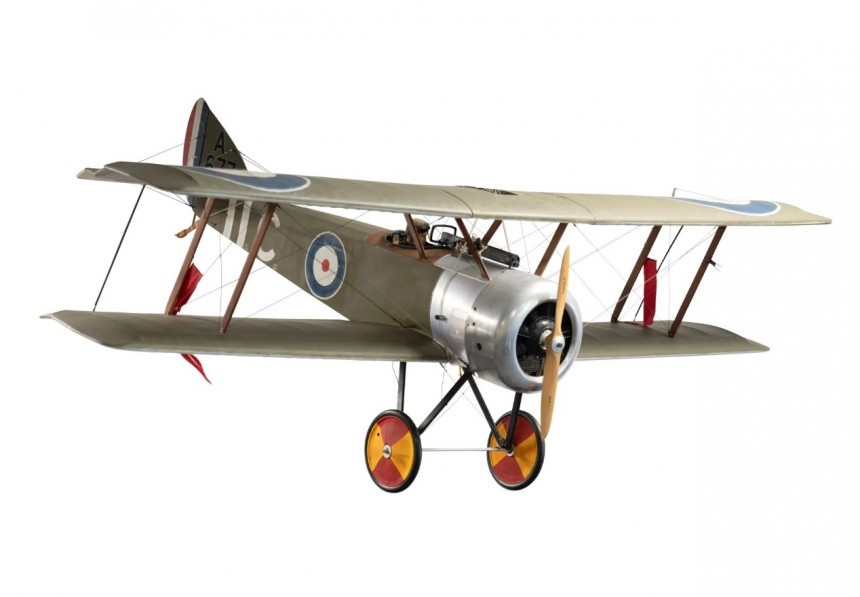In 1962, Ford decided to turn the full-sized Fairlane into an intermediate. Chevrolet responded a year later with the Chevelle, which also happened to become the brand's first entry into the muscle car market with SS. Offered with an increasingly more aggressive design and big-block V8 engines, the Chevelle morphed into a full-blown performance car by 1970.
But it wasn't only muscle car enthusiasts that turned to the nameplate for high-speed thrills. Some drag racers also embraced the Chevelle, dropping 427-cubic-inch (7.0-liter) mills under bulged hoods and burning rubber on drag strips across the U.S.
Come 2022, and many of these historic dragsters are no longer around, but some survivors pop up from time to time after several decades in storage. This 1965 example is one of those cars, and it stands out thanks to a nickname that pays tribute to an iconic World War I airplane.
The original owner decided to name his prized racer "Snoopy's Sopwith Camel." It's unclear whether Snoopy was his actual name or it's just a reference to the famous cartoon character, but it's the "Sopwith Camel" part that we're interested in. Because the Sopwith Camel is a biplane fighter aircraft that became quite legendary during the Great War.
Built by the Sopwith Aviation Company in Kingston-on-Thames, the United Kingdom, the Camel entered service in June 1917 with a Royal Naval Air Service squadron station near Dunkirk, France. Built in almost 5,500 units, the Sopwith Camel was operated by 14 different countries, including the U.S. and the Russian Empire/Soviet Union.
Powered by a single rotary engine and armed with twin synchronized Vickers machine guns, the Camel is credited with downing almost 1,300 enemy aircraft, more than any other Allied fighter during World War I. It remained in service until 1920. Come 2022, and only eight original Camels are known to still exist, so it's quite the rare bird.
While seeing the name of a British WWI plane on an American dragster is unusual, I can totally see why the original owner of this Chevelle went with it. And perhaps he was also a WW1 veteran who actually piloted a Camel? That's a piece of information we don't know, but the seller says the original owner raced the car from the day he got it until he sold it in 1969. And the livery you see on the Chevelle dates back to 1965, which is downright amazing.
So what happened to the car from 1969 until 2022? Well, the seller purchased the Chevelle without a drivetrain and dropped a 283-cubic-inch (4.6-liter) small block under the hood. He also ran it at the drag strip with a tunnel-ram intake and two four-barrel carburetors, which required the addition of a tall scoop in the center of the hood.
He raced the car until 1973, when a blown ring-and-pinion forced the Chevelle into storage. It remained in a barn until 2007, when the roof collapsed and damaged the rear window. While stored outside, waiting for a new barn to be completed, the car was vandalized and had its side window smashed.
Overall, the dragster is an unrestored survivor, and it shows. The red paint no longer shines, while the interior showcases a bit of wear and tear, plus some surface rust on the bare floor panels. A few chassis elements are also covered in rust, but the structure appears to be sound, needing only cleaning and a repaint.
The Chevy comes with replacement glass, an extra driver's door, and a stock hood with hinges. The seller is also offering vintage Cragar S/S wheels, but the tires will need to be replaced. The 283 V8 engine and transmission are no longer in the car, so this Chevelle is now a rolling chassis in need of new drivetrain components. The 12-bolt rear axle is still in there and comes with a new set of 5.57.1 gears.
The seller will also provide some documentation about the car's racing history, including "Niagara International Drag Strip Racing News articles." Located in Prattsburgh, New York, the Chevelle is being auctioned off via Hemmings. Bidding is at only $3,500 with less than a couple of hours left, so this Chevelle may end up being a bargain. Would you fix and race this historic dragster with a cool name?
Come 2022, and many of these historic dragsters are no longer around, but some survivors pop up from time to time after several decades in storage. This 1965 example is one of those cars, and it stands out thanks to a nickname that pays tribute to an iconic World War I airplane.
The original owner decided to name his prized racer "Snoopy's Sopwith Camel." It's unclear whether Snoopy was his actual name or it's just a reference to the famous cartoon character, but it's the "Sopwith Camel" part that we're interested in. Because the Sopwith Camel is a biplane fighter aircraft that became quite legendary during the Great War.
Built by the Sopwith Aviation Company in Kingston-on-Thames, the United Kingdom, the Camel entered service in June 1917 with a Royal Naval Air Service squadron station near Dunkirk, France. Built in almost 5,500 units, the Sopwith Camel was operated by 14 different countries, including the U.S. and the Russian Empire/Soviet Union.
Powered by a single rotary engine and armed with twin synchronized Vickers machine guns, the Camel is credited with downing almost 1,300 enemy aircraft, more than any other Allied fighter during World War I. It remained in service until 1920. Come 2022, and only eight original Camels are known to still exist, so it's quite the rare bird.
So what happened to the car from 1969 until 2022? Well, the seller purchased the Chevelle without a drivetrain and dropped a 283-cubic-inch (4.6-liter) small block under the hood. He also ran it at the drag strip with a tunnel-ram intake and two four-barrel carburetors, which required the addition of a tall scoop in the center of the hood.
He raced the car until 1973, when a blown ring-and-pinion forced the Chevelle into storage. It remained in a barn until 2007, when the roof collapsed and damaged the rear window. While stored outside, waiting for a new barn to be completed, the car was vandalized and had its side window smashed.
Overall, the dragster is an unrestored survivor, and it shows. The red paint no longer shines, while the interior showcases a bit of wear and tear, plus some surface rust on the bare floor panels. A few chassis elements are also covered in rust, but the structure appears to be sound, needing only cleaning and a repaint.
The Chevy comes with replacement glass, an extra driver's door, and a stock hood with hinges. The seller is also offering vintage Cragar S/S wheels, but the tires will need to be replaced. The 283 V8 engine and transmission are no longer in the car, so this Chevelle is now a rolling chassis in need of new drivetrain components. The 12-bolt rear axle is still in there and comes with a new set of 5.57.1 gears.
The seller will also provide some documentation about the car's racing history, including "Niagara International Drag Strip Racing News articles." Located in Prattsburgh, New York, the Chevelle is being auctioned off via Hemmings. Bidding is at only $3,500 with less than a couple of hours left, so this Chevelle may end up being a bargain. Would you fix and race this historic dragster with a cool name?


